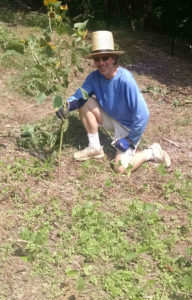Peirce Mill update #1: Sewing a Blanket of Green Ground Cover
In order to build a bridge between tree planting efforts at home and on distant shores, we’re glad to be working with volunteers who have replanted a micro-version of the onetime very large Peirce Mill Orchard here in Washington, DC. In the early 19th century Peirce Plantation and its orchard covered a large area of what is now Rock Creek Park, and it included a mill and many other buildings (including a distillery for apple brandy). A few years ago Treemaster Tim Makepeace and other volunteers at the Friends of Peirce Mill planted 25 valiant fruit trees, and are now studying how they interact with, and help create, healthy soil.
This project echos the work that our tree planting partners are doing all over the world, though of course on a smaller scale and for different reasons. We’re glad of the chance to donate elbow grease to Tim and his crew, and gain direct experience with a project that is similar to the ones that ForestPlanet is supporting in Madagascar, Haiti and elsewhere.

Tim M. rocks Amish Hat and Brand New Cover
The new mini-orchard was planted atop 5-year-old landfill, which means that the supporting soil depth is still shallow. One result of the poor state of the soil is that the orchard’s trees aren’t growing as quickly as they would otherwise. Enter Tim and his efforts to give Nature a fighting chance to create a nurturing soil environment for the fruit trees. Good soil creation can start from the top and work its way down, as long as the right species of cover crops are selected.
Tim identified a diverse blend of cover crops to plant around each tree that “play well with others”. Growing a diverse set of plant species helps drive energy deep into the soil, build the soil structure, and support its microflora (a community of fungi, bacteria, protozoa and other microorganisms). The plants’ roots aerate the soil, scavenge nutrients the trees cannot access themselves and build organic matter in the soil. Above ground, the plants suppress unwanted weeds and self-absorbed grasses, e.g. crabgrass. Flowering cover plants are included in the mix, which attract beneficial insects and birds that feed on pesky aphids and caterpillars.
The cover crop blend includes:
- Buckwheat
- Indian mustard
- Hairy vetch
- Annual ryegrass
- Crimson clover
And it’s working! You can see in the above photo Tim bestowing a warm smile upon a lovely green carpet that’s only one week old. One week, and the orchard’s trees are as happy as the crabgrass is dejected.
And we were glad to sport our one-of-a-kind ForestPlanet t-shirt and help initiate the crabgrass dejection by swinging a heavy mattock at it in the hot August sun, which broke the stuff up and made room for Tim’s cover collection. It was fun working with Tim and the other determined volunteers and we’re looking forward to seeing the results.
The main takeaways are that with the right plan, the right resources, and the right amount of elbow grease, natural processes will kick in and start doing their magic – and do so quickly. Similarly, we see positive and rapid results from the mangrove restoration projects in (say) Madagascar. Further proof, as if any were needed, that Nature knows what to do – anywhere and everywhere.
OK, this is great, but what happened next?

Wonderful work Hank!